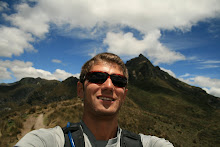
Quito, officially San Francisco de Quito, is the capital of Ecuador in northwestern South America. It is located in north central Ecuador in the Guayllabamba river basin, on the eastern slopes of Pichincha, an active stratovolcano in the Andes mountains. With a population of approximately 1,397,698 in the decadal national census of November 25, 2001, and, as estimated by the municipality, approximately 1,504,991 in 2005, Quito is the second most populous city in Ecuador, after Guayaquil. It is also the seat of the Metropolitan District of Quito, the official name of the canton Quito is located, home to 1,842,201 residents in 2001, and the capital of the Pichincha province. Quito is also to be the headquarters of the Union of South American Nations from 2008.
The elevation of the city's central square (Plaza de La Independencia or Plaza Grande) is 2,850 m (about 9,350 ft), making Quito the second highest capital city in the world.
Quito is located about 25 km (15 miles) south of the equator. A monument and museum marking the general location of the equator is known locally as la mitad del mundo (the middle of the world), to avoid confusion, as the word ecuador is Spanish for equator.
Quito is about 40km (25 miles) long and 5km (3 miles) at its widest, most of the important avenues of the city extend from north to south. The two main motorways that go from the northern part of the city to the southern are Avenue Oriental (Corredor Periférico Oriental) on the eastern hills that border the city, and Avenue Occidental on the western side of the city on the Pichincha volcano. The street 10 de Agosto also goes north to south through most of the city, running down the middle of it.
Quito is located in the northern highlands of Ecuador in the Guayllabamba river basin. The city has been built on a long plateau laying on the west flanks of the Pichincha volcano. Quito is flanked by snow-capped volcanoes that can be visible from the city in a clear day. Some of the volcanoes on the Central Cordillera (Royal Cordillera), east of Quito, surrounding the Guayllabamba valley are Cotopaxi, Sincholagua, Antisana, and Cayambe. Some of the volcanoes of the Western Cordillera, to the west of the Guayllabamba valley, are Illiniza, Atacazo, Pichincha and Pululahua (which has the Pululahua Geobotanical Reserve).
(Information From Wikipedia)


No comments:
Post a Comment